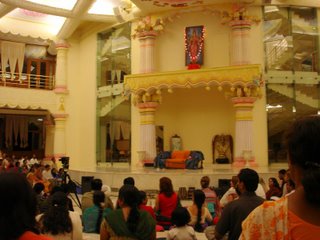Just Breathe

(Above: Ashram "stuppa" like structure where class was held on 4th Floor.)
Breakfast hailed as it was served during the limited window from 7:30 to 8:15. Again, it was the limitations on availability (time) that somehow increased my morning hunger. If we missed brecky, your fuel tank would run on “E” until 12:30 (lunch). It was not the French toast I was craving, but the salted oatmeal textured paste made from rice was the only item on the menu. Stomach paste downed, we headed across the ashram campus to find our classroom for a 9:00 a.m. start. It wasn’t long before we learned that class would not start until 9:50, not 9:45 or 10:00, but 9:50.
Like the pupil I was not in college, we made sure to appear for class several minutes early. By 9:50, 32 pupils were seated on floor pillows before Fathima, our main instructor for the next three days. A single mother of one son in her late thirties/early forties, she wore an attractive green saree and a wide atypically white smile for Indians. A school principal by profession, Fathima immediately took control of the class by setting the ground rules, “Think before you ask questions. Maybe it will be answered in the next few days. Ask yourself, will everyone benefit from this question? People sometimes ask questions to show how smart they are.”
The class of thirty Indian nationals and two westerners (Marc and I) listened in obeyance. Fathima continued, “Do I have your agreement to give 100% over the next three days?” When the class failed to answer audibly, she waited until the collective “Yes” was sufficiently convincing. On the fourth try, a resolute “Yes” belted from everyone’s mouth and Fathima proceeded.
“What is appropriate to do when you come together like this?” she asked with a rhetorical tone. Without losing the class’ firmly fixed attention, she answered, “Introduce yourselves. You will now introduce yourselves to everyone else in the class by standing in front of each other and saying, “My name is ______. I am from ____________. I belong to you.”
Whoa there Nelly, easy, I belong to whom? While I expected we would be introducing ourselves at some point, standing in front of strange men and women saying, “I belong to you” was a new twist. Without time for apprehension to set in, Fathima had everyone on their feet racing around the room standing in front of each other professing their new found beholdeness. It happened so quickly I wasn’t even sure if I missed classmates or even expressed my belongingness twice to the same person.
Add to this new found amazing introduction race, the familiar challenge of learning new names, but this time with an international flare with the names like Kirthi, Mukundan, Ganesakaran, Tushkar and Shivaswamy (and those are the easy ones). India is a country with at least 24 different languages and hundreds of dialects. Fortunately for me, English is the common lingual ground for many Indians, however, it is delivered with a heavy “Inglish” accent. But I surprisingly provided a hurdle of my own, the name Todd, as simple as it seems, is difficult for most Indians to grasp. Thirty-one people later, I was happy that the exercise was over as the idea of belonging to strangers (except Marc) was only palatable as long as my heart and mind remained open to the experience.

(Classroom where it all happened, except for morning yoga.)
Class again seated, Fathima asked us to write down our expectations from the course. Five minutes later, hands were raised in response to her request for sharing answers people had written. After a handful of answers were offered, Fathima concluded the expectations issue with, “You will get none of the things you expect. If you don’t like that, then you can get a refund now.” Ouch, was this the Art of Living or boot camp? The lines were getting blurrier by the minute, but her point was revealed as she steered into us into our first group discussion.
“What happens when we have expectations?” she asked. This was a point with which I was familiar. When you have expectations you stand the chance of getting disappointed if what you expect falls below your expectation. Lesson number one, understood.
As the morning ticked on, the class engaged in a number of smaller group activities about which I will not go into further detail as the shared feeling of the experience cannot be adequately conveyed. The main point of the morning exercises was to demonstrate the difference in feelings when one is apart of a group.
According to the Art of Living course there are four sources of energy for the body: rest (sleep), air (breathe), food and knowledge. The core of the course was to address each source either via exercise or discussion. For three days, discussion volleyed between each of the sources in no apparent order. Of the four sources, breathe would take front stage to the others.
Repeating each of the discussions here would not do any of them justice. Behind them was what I describe as a “soulful knowing” that was being evoked in each person. And this “knowing”/feeling was an important piece to understanding the puzzle so taking the class is the only true way to grasp the concept behind the Art of Living.
That being said, I will mention that the key to the course centers on breathing techniques handed down for centuries amongst the yogis. A combination of Pranayama, Vastrika and Kriya breathing and yoga practice is used to bring a union between the body, mind and universe. Practicing each of the breathing exercises in the morning lead to our first full session of the combined exercises in the late afternoon on Day 1.
Eyes closed and spread out across the room, the class followed Fathima’s basic and short instructions for forty-five minutes. This being my longest mediation ever, I wondered if I would make it to the end. The postures involved specific placement of hands, sitting posture and manipulation of the diaphragm through long, medium and short breaths. At times, some of the short breaths left me feeling light headed and I took slight breaks to maintain consciousness perhaps from hyperventilation or improper technique.
When the formal Kriya exercise was completed, we were told to relax onto our backs and keep our eyes closed. What followed was unique for each person, but with some common sensations. My own feeling was an immediate sense of being more connected to myself and my environment. There was a sense of serenity, peace and overall well being. Having never put so much effort to look inward, I yearned to stay in it as long as possible. To the trained yogi or experienced meditator, a fly on the nose, the sound of someone snoring nearby or the flood of thoughts from your “to-do” list is easily kept at bay. A novice to the art, after a few minutes, I found myself distracted by the snoring of a man who sounded like he had the aid of a blowhorn.
“Would someone wake him up?,” I screamed in my mind, “he’s ruining my meditation.”
To no avail, he kept snoring and was even joined a few minutes later by another man for whose wife I also feel sorry. That was another challenge of meditating, not going to sleep. While I was fortunate to avoid that pitfall, staying in my peace was experiencing massive turbulence. Fathima issued the “slowly rise” order, signaling the end of our first Kriya session. I rose slowly, still clinging to the sense of peace within. When I opened my eyes, several bodies lay still either deep in meditation or asleep. Sweetened biscuit cookies were distributed aiding my return to full consciousness.
Class concluded for the day and Marc and I returned to our room comparing experiences along the way. We had little time before dinner and were excited about the special guest. Again good fortune shone upon us as we had learned the day before that Sri Sri Ravi Shankar (referred to as “Guruji” by his devotees) had made a rare return to the ashram and would preside over the evening satsang for the next few days. The ashram was abuzz with this news. People that worked on the campus seven days a week had a noticeable skip in their step at the mention of Guruji’s presence at the ashram.
Marc and I made sure to get to the indoor marbled amphitheatre on time so as to secure a seat. While satsang the prior evening was well attended, tonight was no doubt going to be a full house with Guruji’s return. Electrified energy filled the air as hundreds seated Indian style on the floor sang from their hearts professing their respect for God and the existence of something greater than themselves. The songs were sung by people from all religions, Hindu, Muslim, Christian, Jewish and Jain. “God” in this house was not thought of by all in precisely the same fashion, this was what might be referred to as “shakti” which is the energy source believed to represent “God”.

(In satsang waiting for Guruji.)
Guruji arrived forty-five minutes into the singing. The crowd stood up and remained standing until Guruji assumed a seat on the couch centered on the stage. The singing resumed with the band playing harmonious music from the front row. Guruji sat on the couch for an hour, eyes closed, head nodding from either sleep or a deep trance. When he opened his eyes, the music stopped and the crowd waited for the pearls of wisdom to flow. But on this night, his first night back in many weeks, words would be few and only those with birthdays and anniversaries would be invited to the stage to receive a blessing.
Returning to our room, I took a cold bucket shower, the only kind available and collected my thoughts on the day. Ashram bed time is early as many wake at 4 or 5 for sadhna and those of us taking the basic course were due on deck at 6:30 a.m. for yoga. Earlier Fathima had warned us not to be late or a punishment would be rendered bringing back fresh memories of every phys. ed. teacher I ever came across. I didn’t like to run extra laps then and that had not changed, we would be on time, alarm clock willing.


<< Home